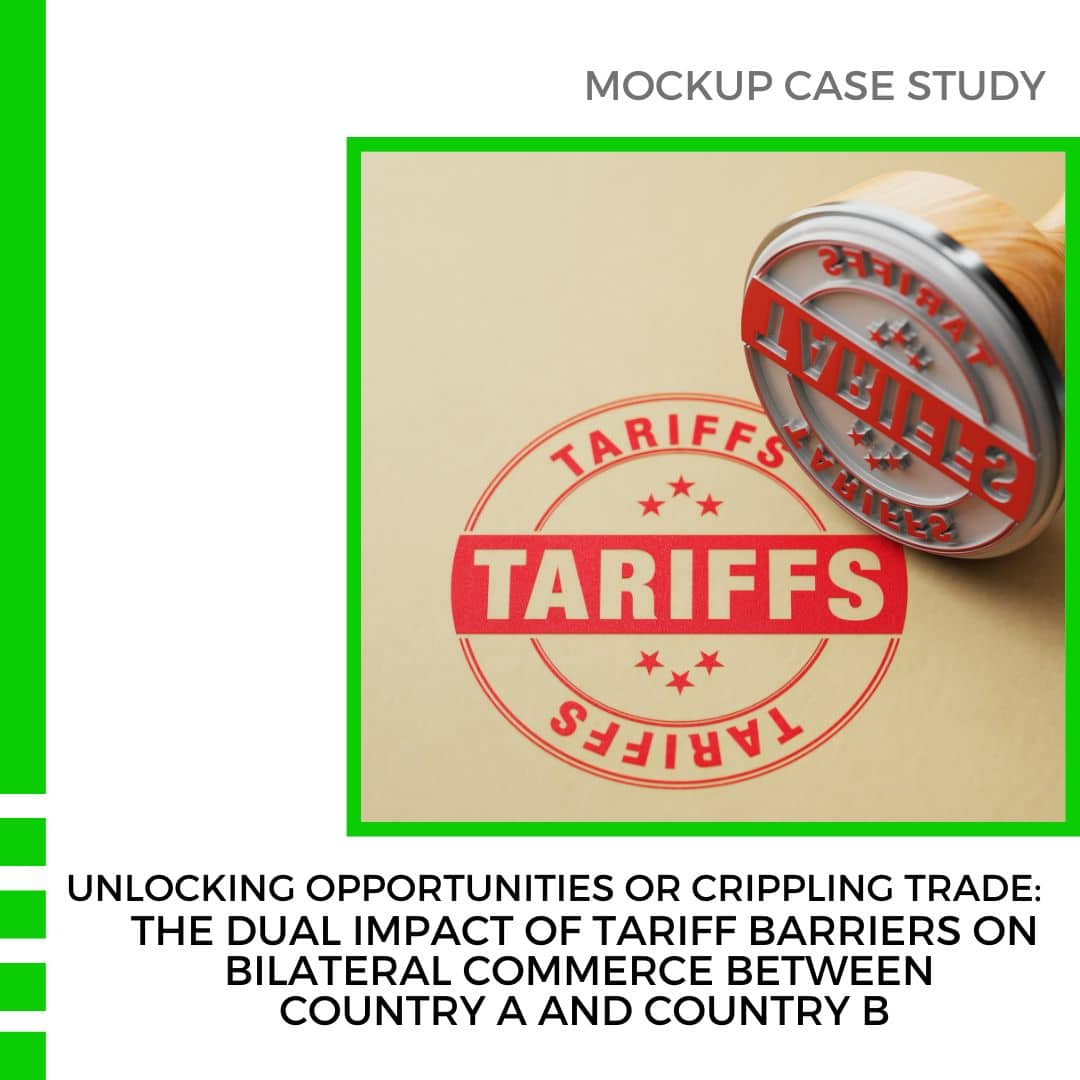
Fostering Opportunities or Stifling Trade: The Dual Nature of Tariff Barriers on Bilateral Relations Between Country A and Country B
Introduction
This case study examines the economic repercussions of tariff barriers imposed by two fictional countries, Country A and Country B. These tariff barriers have significantly impacted the import and export activities between the two nations, leading to economic challenges and strategic dilemmas for businesses operating within these borders. Students are tasked with analyzing the situation, understanding the underlying factors, and proposing solutions to mitigate the adverse effects of these trade barriers.
Background
Overview of Country A and Country B
Country A: An industrialized nation recognized for its advanced technology and manufacturing sectors. It exports high-tech machinery, electronics, and pharmaceuticals, playing a crucial role in global supply chains.
Country B: A developing nation with a strong agricultural base and a growing industrial sector. It exports agricultural products, textiles, and raw materials essential for various industries worldwide.
Trade Relationship
Historically, Country A and Country B have enjoyed a robust trade relationship. Country A has been a significant importer of agricultural products and raw materials from Country B. At the same time, Country B has relied on advanced machinery and pharmaceuticals from Country A to support its industrial growth and healthcare sector. This interdependence has fostered mutual economic benefits, enhancing the growth prospects of both nations.
Key Events Leading to Tariff Barriers
Economic Disputes
The economic dispute between Country A and Country B began over trade imbalances and disagreements regarding intellectual property rights. Country A accused Country B of unfair trade practices, including the alleged dumping of agricultural products at below-market prices and inadequate protection of intellectual property rights. These accusations created a rift in the previously cooperative trade relationship.
Imposition of Tariffs
In response to these disputes, Country A imposed tariffs on essential imports from Country B, including agricultural products, textiles, and raw materials. Country B retaliated by imposing tariffs on high-tech machinery, electronics, and pharmaceuticals from Country A. These tariffs, ranging from 15% to 25%, have significantly increased the cost of importing goods between the two countries, straining their economic ties.
Escalation and Diplomatic Strain
The imposition of tariffs has led to diplomatic tensions between Country A and Country B. Attempts at negotiation have stalled, with both countries entrenched in their positions. The economic impact of these tariffs is being felt across various sectors in both nations, contributing to a volatile trade environment.
Impact on Trade
Country A
- Increased Costs: Manufacturers in Country A face higher costs for raw materials and textiles, resulting in increased production costs and reduced competitiveness in global markets. These heightened costs threaten the profitability of local firms and may lead to downsizing or closures.
- Supply Chain Disruptions: The agricultural sector in Country A is experiencing supply chain disruptions, affecting food production and prices. Farmers struggle to secure affordable imports, leading to higher consumer costs and decreased availability of certain products.
- Consumer Prices: The increased costs of imported goods have led to higher consumer prices, affecting the overall cost of living. This inflationary pressure may decrease consumer purchasing power, further impacting domestic demand.
Country B
- Reduced Exports: The tariff barriers have significantly reduced the exports of agricultural products and textiles to Country A, adversely affecting the income of farmers and manufacturers. Many producers are facing financial distress as their primary market has contracted.
- Industrial Slowdown: The increased cost of importing high-tech machinery and pharmaceuticals has slowed industrial growth in Country B. This slowdown hampers the country’s ability to advance technologically and improve its healthcare services, affecting overall quality of life.
- Economic Strain: The overall economic strain is evident in reduced GDP growth and increased unemployment rates. With diminished export revenues, Country B faces fiscal challenges that may lead to broader economic instability.
Strategic Challenges
Trade Diversification
Both countries must explore alternative markets and trade partners to mitigate the impact of the tariffs. This requires identifying new trade opportunities and establishing reliable trade agreements that cushion their economies from the adverse effects of tariff barriers.
Domestic Policy Adjustments
It is crucial to adjust domestic policies to support affected industries. This includes providing subsidies, tax relief, and other financial support to businesses impacted by the tariffs. Such measures can help stabilize these sectors while they adapt to the changing trade environment.
Negotiation and Diplomacy
Reviving negotiations and diplomatic efforts to resolve the trade disputes is essential for restoring normal trade relations. This involves addressing the underlying issues of trade imbalances and intellectual property rights, fostering a cooperative rather than confrontational atmosphere.
Tasks for Students
Task 1: Impact Analysis
Analyze the economic impact of the tariff barriers on both Country A and Country B. Consider the effects on various sectors, including manufacturing, agriculture, and consumer markets.
Task 2: Trade Diversification Strategy
Develop a trade diversification strategy for both countries. Identify potential new markets and trade partners and propose steps for establishing trade agreements and partnerships.
Task 3: Domestic Policy Recommendations
Propose domestic policy adjustments to support industries affected by the tariffs. Consider subsidies, tax relief, and financial support for affected businesses.
Task 4: Negotiation Plan
Design a negotiation plan to resolve the trade disputes between Country A and Country B. Outline key negotiation points, potential compromises, and strategies for rebuilding diplomatic relations.
Task 5: Long-Term Economic Strategy
Create a long-term economic strategy for both countries to reduce dependence on bilateral trade and enhance economic resilience. Consider diversifying the economy, investing in innovation, and improving domestic production capabilities.
Conclusion
The tariff barriers between Country A and Country B present a multifaceted challenge that requires in-depth analysis due to their far-reaching economic implications. These tariff barriers affect bilateral trade and influence domestic industries, consumer prices, and international relations. Students are tasked with examining these tariff barriers from various perspectives, evaluating their impact on both economies and considering how strategic solutions could mitigate adverse effects. By addressing tariff barriers, this case study encourages students to apply theoretical knowledge to a real-world scenario, enhancing their critical thinking and problem-solving skills in global trade and diplomacy.
Possible Solution for Tariff Barriers
A practical solution to mitigate the negative impacts of tariff barriers is to initiate Bilateral Trade Negotiations to resolve the underlying disputes between the two countries. These negotiations would address the specific concerns of both nations. For instance, Country A could agree to reduce its tariff barriers on agricultural products, textiles, and raw materials imported from Country B, thereby providing relief to exporters and farmers in the latter. In return, Country B would strengthen its intellectual property protections and enhance trade practices, eliminating unfair trade practices such as product dumping. This reciprocal arrangement would help scale down the existing tariff barriers and restore healthy trade relations.
In addition to negotiations, both countries could adopt trade facilitation measures to reduce the transaction costs imposed by tariff barriers. Simplifying customs procedures, harmonizing product standards, and introducing digital platforms for documentation could help businesses overcome the delays and financial burdens caused by these tariff barriers. Such reforms would encourage smoother trade flows and benefit industries on both sides by reducing dependency on retaliatory actions.
A critical component of this strategy would be establishing a joint trade committee responsible for monitoring the implementation of agreements. The committee would also ensure that any emerging issues related to tariff barriers are addressed promptly, preventing further escalation. By creating this mechanism, both countries could foster ongoing dialogue and reduce the likelihood of future tariff barriers that disrupt trade.
Ultimately, this approach provides a balanced way forward by lowering tariff barriers while protecting key economic interests for both parties. It also promotes long-term cooperation and ensures that each country’s industries can operate competitively in a global market.
References
- World Trade Organization (WTO) – Tariffs: WTO – Tariffs
- International Trade Administration – Tariffs: International Trade Administration – Tariffs
Explore Business Models of Global Companies and Indian Companies.



